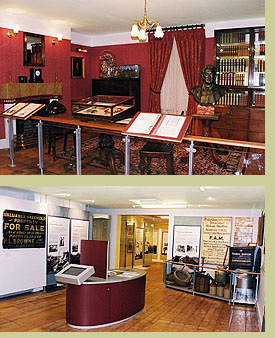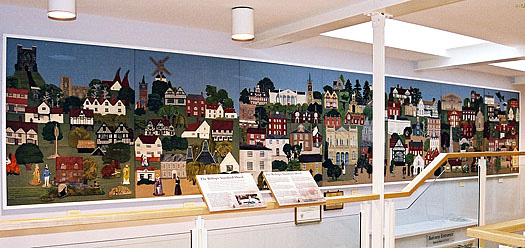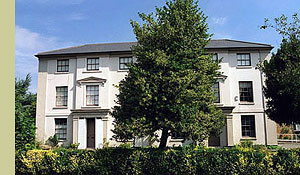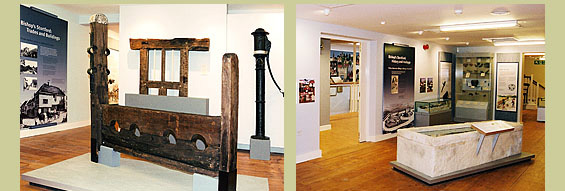|
After an 18 month closure for refurbishment, the new Bishop’s Stortford Museum and Rhodes Arts Complex was officially opened on Friday 11 November 2005. A plaque to mark the occasion was unveiled by Guest of honour Sir Colin Lucas, warden of the Rhodes Trust from Oxford. Admission to the general public took place 15 November 2005. The museum provides displays and activities for a range of visitors from schools and families to tourists or researchers; there is something for everyone.
 Ten new permanent galleries are accompanied by an education room and a spacious temporary exhibition gallery, where it will be possible to view paintings, drawings and sculptures, in-house museum shows using the reserve collection and the Bishop’s Stortford Open Art Exhibition. The permanent galleries on the first and second floors take visitors from imperial Africa to Roman Bishop’s Stortford. Displays of previously unseen objects and photographs open up the town’s history and reveal a past full of hidden treasures. Ten new permanent galleries are accompanied by an education room and a spacious temporary exhibition gallery, where it will be possible to view paintings, drawings and sculptures, in-house museum shows using the reserve collection and the Bishop’s Stortford Open Art Exhibition. The permanent galleries on the first and second floors take visitors from imperial Africa to Roman Bishop’s Stortford. Displays of previously unseen objects and photographs open up the town’s history and reveal a past full of hidden treasures.
The first floor invites you into a Victorian Drawing Room where you will be able to see ladies costumes or have a go at turning a 19th century mangle. And the sound of drums will draw you into a world of wooden sculptures, intricate beadwork and Maasai spears as you follow the journey of Victorian explorers into Africa.
On the second floor Titus, our Roman skeleton will greet you as you discover the ancient history of Bishop’s Stortford. Neolithic axe heads and Roman coins bring the town’s early settlement to life whilst the Great Seal of Bishop’s Stortford, on loan from the British Museum, will help you find out how the town got its name in the 16th century.
Look at the Thorley stocks, find out about the coming of the railway and learn how the famous ‘Gilbeys Gin’ started life in our region. Computer touch screens, quizzes, interactive games and costumes to try will all help your visit come to life.
Bishop’s Stortford Museum is housed within ‘Rhodes House’, the listed buildings where Cecil Rhodes, Victorian empire builder, was born and raised until he travelled to Africa at the age of seventeen. He went on to become Prime Minister of the Cape Colony and founder of De Beers mining company after annexing African land in the name of the British Empire.
To find out more about the new museum and its amazing collection please call: 01279 651746
|
|




 South Road
South Road Ten new permanent galleries are accompanied by an education room and a spacious temporary exhibition gallery, where it will be possible to view paintings, drawings and sculptures, in-house museum shows using the reserve collection and the Bishop’s Stortford Open Art Exhibition. The permanent galleries on the first and second floors take visitors from imperial Africa to Roman Bishop’s Stortford. Displays of previously unseen objects and photographs open up the town’s history and reveal a past full of hidden treasures.
Ten new permanent galleries are accompanied by an education room and a spacious temporary exhibition gallery, where it will be possible to view paintings, drawings and sculptures, in-house museum shows using the reserve collection and the Bishop’s Stortford Open Art Exhibition. The permanent galleries on the first and second floors take visitors from imperial Africa to Roman Bishop’s Stortford. Displays of previously unseen objects and photographs open up the town’s history and reveal a past full of hidden treasures.